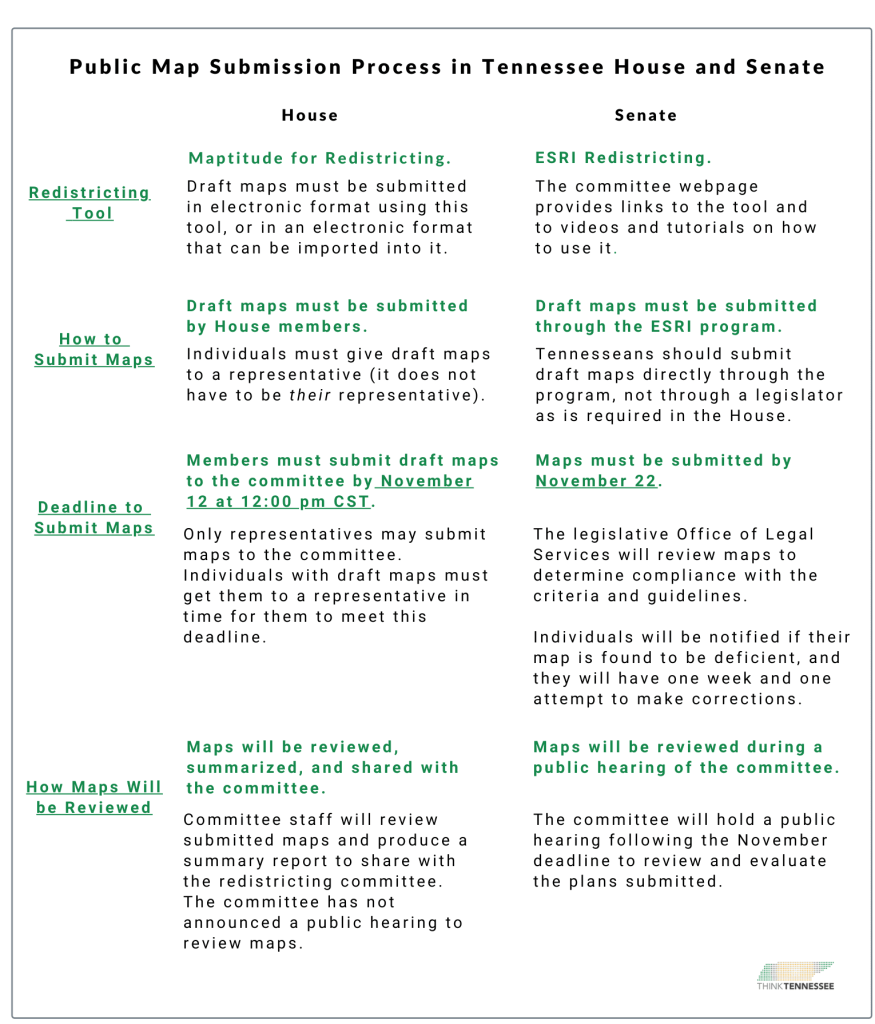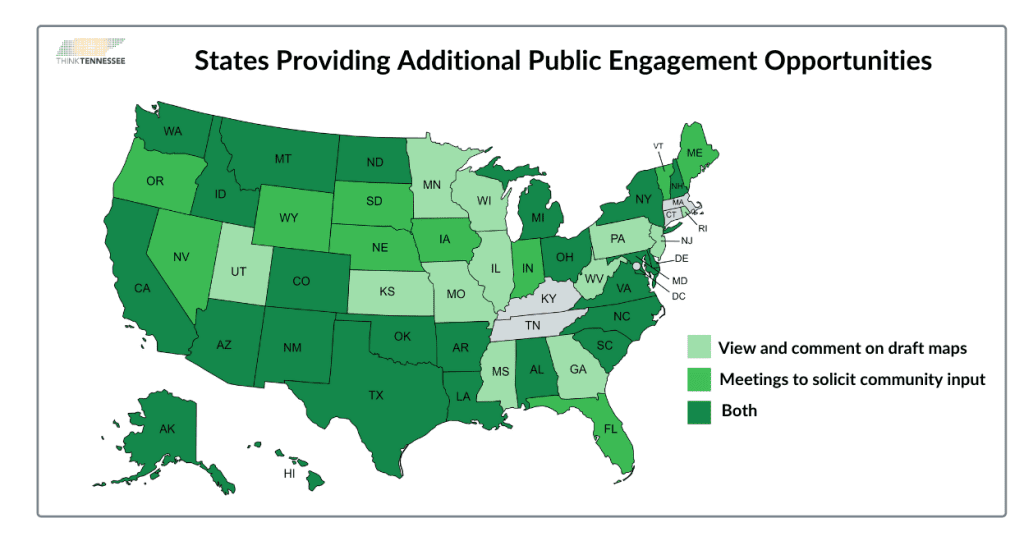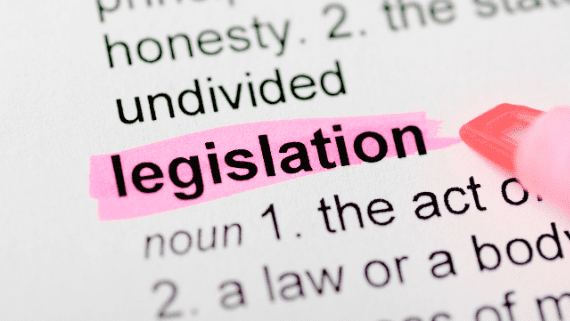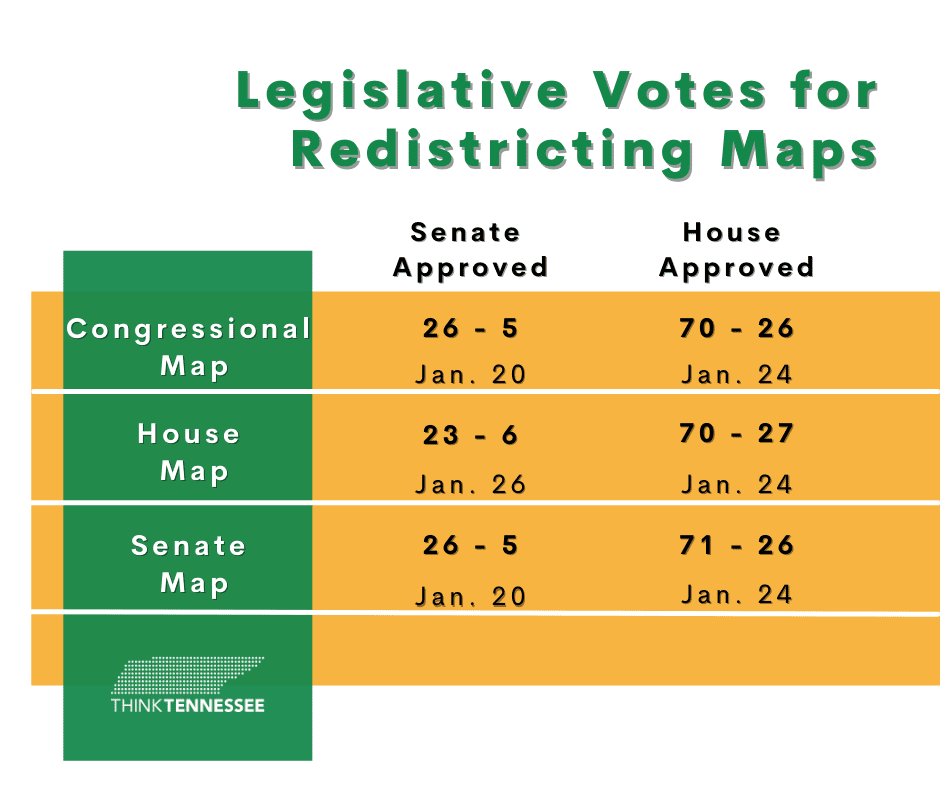Tennessee’s redistricting process officially kicked off this fall. Both the House and the Senate formed redistricting committees, and each has now held its first meeting.
This summer, ThinkTennessee published a primer that outlined the redistricting process, from its legal requirements to suggested opportunities to increase community engagement. Earlier this month, we released an overview of how peer states are seeking public input and actively sharing redistricting information.
Now that the redistricting committees have met, details have emerged about how this once-in-a-decade process will work this time. Interested in learning about current opportunities for community engagement, how this year’s redistricting process compares with previous cycles or additional options for legislators to consider if they want to increase public input?
Here’s what we know so far…
CURRENT OPPORTUNITIES FOR COMMUNITY ENGAGEMENT
Tennesseans can participate in the redistricting process in three ways: (1) contacting state legislators, (2) submitting draft maps and (3) watching – and potentially participating in – the legislative process.
- Contact state legislators to share your input. Tennesseans who have questions about the process or would like to share information about their communities can contact state legislators and staff directly. Both redistricting committees have a webpage (House and Senate) that lists committee members and general contact information.
- Submit draft maps. Tennesseans may draw and submit their own legislative maps for consideration. Both chambers require full state maps (not just individual districts) and compliance with laws and guidelines, which can be found on the House and Senate webpages. The process for submitting maps, however, varies for each chamber:

- Watch – and potentially participate in – the legislative process. Additional meetings of the redistricting committees can be expected this year. Keep an eye on the committee webpages (House and Senate) for scheduling. All three newly redistricted maps will be presented and passed in both chambers and then sent to the governor for his signature. The Tennessee House and Senate each draw their own district maps, and the two collaborate to draw the map for U.S. Congress. The bills that will serve as the vehicles for each map have already been introduced and are available online: House, Senate, Congressional. Given the April 7, 2022 qualifying deadline for candidates running in the newly drawn districts, these bills will be among the first passed in the 2022 legislative session.
THE LEGISLATIVE PATH TO FINAL MAPS
- Step One: Redistricting Committees. The Senate and House redistricting committees will consider draft maps, with the Senate committee also including qualified maps submitted by the public, at hearings in December or January. Each committee will vote to approve a House, Senate and Congressional map. These committee hearings will be open to the public and streamed online. Neither has yet announced whether public comment will be accepted, but both previous committee meetings have allowed time for comment.
- Step Two: Standing Committees. The bills will advance to the Public Service Subcommittee and the State Government Committee in the House, and to the Judiciary Committee in the Senate. These committee hearings will be open to the public and streamed online. As traditional legislative hearings, members of the public may request to provide testimony.
- Step Three: Floor Vote. Each Chamber will consider the bills containing the House, Senate and Congressional maps.
- Step Four: Governor’s Signature. The governor will determine whether to sign or veto each of the bills.
HOW TENNESSEE’S 2021-2022 REDISTRICTING PROCESS COMPARES WITH PREVIOUS CYCLES
While there are some laws and guidelines outlining the redistricting process, Senate and House leadership have the flexibility to dictate how the process will look each cycle. To see how the 2011-2012 process worked, take a look at our three-part redistricting brief series here.
This year’s process differs in four key ways:
- Both the House and Senate announced redistricting committees and held public meetings announcing redistricting guidelines. In 2011, it appears only the House held a committee meeting prior to the 2012 legislative session.
- Both chambers invited public comment at these committee meetings. A public comment period was not on the agenda of the House committee in June 2011.
- Both the House and Senate redistricting committees are bipartisan. There are 16 members on the House committee, 12 Republicans and 4 Democrats. The Senate committee of seven members includes five Republicans and two Democrats. In 2011, all redistricting committee and task force members were from the majority Republican Party.
- The Senate will hold a public hearing to review publicly submitted maps. While both chambers accepted publicly submitted maps in 2011, it was unclear how the maps were reviewed or considered.
ADDITIONAL COMMUNITY ENGAGEMENT OPPORTUNITIES LEGISLATORS CAN CONSIDER NOW
This year, Tennesseans have a once-in-a-decade opportunity to understand and participate in redistricting, and legislative leaders have expressed their commitment to making our state’s process an open one.
Many states in the South host legislative hearings and community meetings that include options for virtual participation, and they share draft maps before they are finalized to allow residents time to meaningfully weigh in. These ideas may hold lessons about how to increase community engagement in our own state.
- Legislatures in 36 states are hosting meetings to solicit community input to help inform the map-drawing process. These meetings, typically held at locations around the state and often including opportunities for virtual participation, invite residents to share their insights about how they define their communities and which legislative boundaries would be most appropriate.
- In 34 states, residents can view draft maps proposed by the legislature and provide comments before they become final. In some states, like Texas, maps are posted online and made available for public review in real time. And in others, like Arkansas and Louisiana, legislative committees will host public meetings to gather feedback on draft maps.






